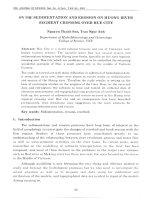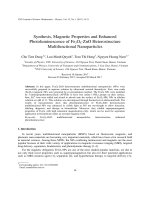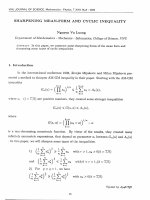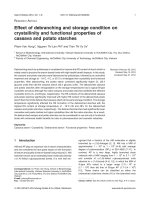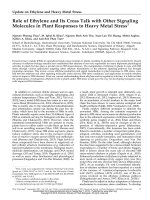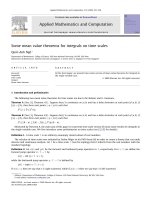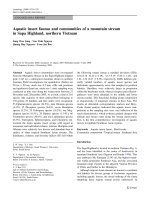DSpace at VNU: Sharpening mean - form and cyclic inequality
Bạn đang xem bản rút gọn của tài liệu. Xem và tải ngay bản đầy đủ của tài liệu tại đây (2.58 MB, 8 trang )
VNU JOURNAL OF SCIENCE, M athem atics - Physics, T .X X II N q 4 - 2006
S H A R P E N I N G M E A N -F O R M A N D C Y C L IC IN E Q U A L IT Y
N guyen Vu Luong
Department o f M athem atics - Mechanics - Informatics, College o f Science, VNƯ
A bstract . In this paper, we construct some sharpening forms of the mean form and
sharpening some types of cyclic inequalities.
1. I n t r o d u c t i o n
In the international conference 1996, Zivojin Mijakovic and Milan Mijakovic pre
sented a method to sharpen AM-GM inequality in their paper. Starting with the AM-GM
inequality
where
(lị
(i = l , n ) are positive numbers, they created some stronger inequalities
where
is a non-decreasing monotonic function.
By virtur of the results, they created many
infinitely symmetric expressions, th a t depend on parameter a , between G„(a) and i4n (a)
. In this paper, we will sharpen some types of the inequalities.
with r > 1, dfc > 0(k = 1, n)
1)
and
2)
with 0 < r < 1, (k = 1, n)
For
p > q > 1, we have
with a* > 0 (k = 1, n)
Typeset by
21
N g u y e n Vu Luong
22
3)
V -----—-----+ — ——
J ^ a fc + a fc+1 a„ + ai
n —2
Y
^
4)
’
(where
2
with ajfc > 0(fc= l , n )
2
„2
„2
1
n
_____Ạ ____ +
»--1— + — ^ ---- > - i - y a k
ak+l + (3ak+2
an + /3a 1
Oi + 0 a 2
1 + /? "
ajt > 0, /c = ITn
and
/? > 0
is given).
2. S h a r p e n i n g m e a n - f o r m in e q u a lity
We denote
Bn (a ,p ,q ,a )=
where a A: > 0
1 n
£
1
^ { a pk + a ) ? ) p - a 9,
k=l
(k = 1, n );p > 0; Ợ > 0; a > 0.
We have
£ n (a,p, 1, a ) = ( -
+ a ) p) p -
Q
k= 1
1 n
1
B „ (a ,p ,1 ,0 )= ( £ l > ỉ )
fc= l
1
V -.
B n (a, 1 , 1 , 0 ) = — 2_J a k-
fc=i
Let us consider the inequality
B n (a, r, 1,0) ^ B n (a, 1 ,1 ,0), wherer > 1
B n (a, r, 1,0) ^ B n (a, 1 , 1, 0)where0 < r < 1.
L e m m a 1.1. z?„(a,r, 1, a ) is a non - increasing monotonic function (with variable a).
Proof. We have
Z?;(a,r,l,Q)=
5 Z(afc + a)r)^ 1
fc=i
Therefore
Y , r(a* + Q)r_1)l
fc=i
,
p/ /
1
\
ỉE ìĩĩC a ib + a r 1
.
B n {a,r, 1,a ) = ---- — — — --------- EZT - L
( i E S V + a r) ;
~ L
S h arpenin g m e a n - f o r m a n d cyc lic inequality
Denote Ak = (a* + a ) r_1 and q =
We get
J_ ir^k—n .
r ,l,a ) =
t 1 ,, - 1 (ÌE Ỉ:^ ỉ) A
If r > 1, then Ợ > 1 and if 0 < r < 1, then
<7 <
0. It yield
1 k=n
k—Ti
( ^*=1Ẻ V ^ Ẻ fc=iV
Therefore, B'n (a,r, 1, O
r)
< 0 and 5 n (a ,r, l , a ) is non-increasing.
L e m m a 1.2. (i) B n (a,r, 1,0) ^ 5 n (a ,r, 1,q) ^ 5 n (a, 1,1,0) where r > 1
(a)
& n(a,r, 1,0) ^
B n ( a , r,
1, O
^ Bn(a, 1 , 1 , 0) where 0 < r < 1.
r)
/Yoo/. Let us consider r > 1. By inequality of Minkowski, we have
B n ( a , r , 1,0) ^ B n(a,r, l , a )
.1 ^ ^
1 k —Ti
1 /_
Jc=l
« ĩ)
. /
> ( i Ị > +«>')
- “
Jfc=l
fe=n
A:=n
fc=n
fc=l
*=1
jfc=l
It is learn th at £?n (a, r, 1, a ) ^ £?n(a, 1,1,0) is equivalent to
/ 1 ^~n
1/r-
1 *= n
« ( £ ! > + « ) ')
*=1
* * (- ;
fc=i
+
a ) r ) 1/r -
a
>
fc=i
A:=l
+ « ) ) - < *
fc=i
+
^ n
^ (afc+a)
Jt=l
For 0 < r < 1, the proof is similar.
For p > q > 1, we have
B n (a,p, 1,0) ^ 5 n (a,ợ, 1,0).
Theorem 1.1. Given p > q > 1, a ^ 0, Ojfc > 0, (k = T~ri). Then
( i) B n (a,p, 1,0)
^ B n (a, p, q, a) ^ B n (a,q, 1,0).
( ii) B n (a,p, q, q ) is a non-increasing monotonic function (in variable a).
N g u y e n Vu L u on g
24
Proof.
(i) Denote Ak — aqk , the required inequality is equivalent to
!/Q
z
fc=l
<
a) ■ " > [ ( ;
,/P
/c=l
l i t
fc- 1
A
Taking the q power of both sides and set r - p /<7 > 1, we obtain
^ %
^ >
n k=l
^ ị i A
k=l
k+ aỴr
-
a > ^ ị A k.
k= 1
Applying the lemma(1.2) deduces th a t the inequality is true (ii) Let aqh - A k ,r
V
- >
1 , then the function
> 1,
Q
^ k=n
B n { a ,p ,q ,0 ) =
l/r
+ Q )r ))
—Q
fc=1
is a
n o n - increasing
monotonic (Lemma 1.1).
3. S h a r p e n i n g s o m e t y p e s o f t h e cyclic i n e q u a litie s
We denote
r (
It follows
Ì_
V'
(a f c + Q)2
K
+ a )2 _
k—n—1
9
o
—
at
a*
G „ (a ,0 )= E
a
+a
7—^ ữfc+l
al
A:= 1
Wc will strengthen a simpler inequality
fc=n
G n (a, 0)
^ ^ flfc — 5 n(a),
fc=i
where a, > 0, i = 1, n. We obtain the following result.
T h e o r e m 1.2.
( i) Gn ( a , a ) is a non-increasing monotonic function.
( ii) Gn (a, 0) ^ G n( a ,a ) ^ s„ (a ).
Proof.
1/9
S h a rp en in g m e a n - f o r m a n d c y c lic in eq u a lity
We have
(Qfc + Q ) 2 _ (ft + Qfc+ 1 + ak - Qfc+i) 2
Gfc+1 + OL
a fc+i + Ot
— Q + dfc+ 1 + 2(a*; — ajfc+i) + —------ A i l l Ofc+l + cv
Therefore,
k — 71
k — fi
Gn ( a , a ) = V a t +
fc=i
V
è í
1/ > 2 /
\ *■
K - “ *+.) + (a- - 3 l ) :
a* + i+ ữ
a i+ a
We have
G' (a, a ) = - (\
a i >2 - £
(a + a i)
"
f a - at+ 1>2 ặ 0.
(a + ajt-fi)2
Hence G n (a, a) is a non-increasing monotonic function.
Since Q ^ 0, we get
G n (a ,a ) ^ G n (a, 0).
We have
k = n —l
- f
^ ± £ f + ^ ± 2 ) ! / f (a t+ a ).
a fc+1+ a
a i+ a
^ ^
Then
k=n
k —n
(a/c + a ) - n a — £
Gn (fl,a) ^ £
k= 1
jfc=l
(Theorem is proved).
We denote
£>n (a a ) =
V
“
1 __ ± Q)2
_|_ (Qn + tt)2 _ n a
a fc + afc+ i + 2or
an + a ! + 2a
2 ’
where a ^ 0.
It follows that
k = n —1
D n (a, 0) =
2
2
£
— p . ----- +
a“= 1 G
afc
fc + G
a fc-f
fc+11
an + ai
We will sharpen an inequality
D n {a, 0) ầ
^ ' cifc — rt*^n(a )
fc=i
where a* > 0, i = 1, n. We obtain the following result.
N g u y e n Vu L u o n g
26
T h e o r e m 1.3.
(i) D n(a, a ) is a non-increasing function.
(ii) D n (a, 0) ^ D n ( a , a ) ^ ^ S n (a ).
Proof. We have
_ a 2 + 2 a fca + aị
(afc + a ) 2
Gfc + a j t + i + 2 a
2 a + afc + afc+ i
o
/ (afc-Qfc+l
3afe — afc+ 1 ^
a
2
4
2
t
J
2 a + (Zfc + flfc+ 1
It follows that
n
,
n (a .a )
n' (
n
l fc^
, l ^
2 ^ afc 4 “
\
V "'
2
1 K ~ a * +i)2 , 1
(fln -Q i)2 :
2 a + a fc + dfc+ 1
4 2 a + a n + ai ’
(fl/c
afe+i)2
_ 1_
{ 2 a + afc + afc+i)2
2
(a n
Qi ) 2
<
(2a + a n + a i ) 2
—
~
Q
Hence D n(a, a ) is a non-increasing monotonic function. Since a ^ 0, D n (a ,a ) is a nonincreasing monotonic function. Therefore
D n (a, a) ^ D n (a, 0)
D n (a, a ) ^ - S n (a).
To complete the proof., we will show th a t
We have
n(
\ = k\ ' i
(Qfc + Q)2
[a i a )
2_> afc+afc+ i + 2 a
k=l
1
fc=n
_
(a » + Q)2
an + a i + 2 a
na
2
1 fc=n
1 v -''/
\
nQ
1
_
l ^ ( a k + a ) - — = 2 ^ _ ak'
k= 1
fc=l
Theorem is proved.
We denote
\ = V ' _______ (afc + a ) 2_______
a’a
"
k= 1
afc+ 1 + p ũ k +2 + (1 + / 3 ) a
(an_ i + Q f ) 2
a n + p a i + (1 + /ổ)a
(an + a ) 2_________ na
a i + P a 2 + (1 + ậ ) a
1 + Ị3
(where variables Q ^ 0 and (3 > 0 is given )
It follows that
Fn (a, 0) =
áỉ
á ị-l
an
-----------—-------- 1-----------------1-------~ 3
dk-ị-1 + Ị3dk+2
a n + /3ai
We will sharpen the inequality
Fn{ai 0)
We obtain the following result
^ “ p S n (a).
a i + (3a 2
S h a rp en in g m e a n - f o r m a n d c y c lic in e q u a lity
T heorem 1.4.
(i) Fn (a:a ) is a non-increasing function
(ii) Fn (a, 0) ^ F n ( a , a ) ^ j - ^ 5 n (a).
Proof.
We have
________ (a k + o p 2________ _
Q2 + 2 Ok a + á ị
GA. + 1 + 0a-k+ 2 + (1 + 0 ) a
(1 + j3)a -f ajfc+ 1 + Paic+ 2
( fifc fi
1 + /2
1 + /?
(1 + /3)2
__ Q _|_
_ ak + 1 + /fafc + 2
1 + /?
1 + /3
(1 + /3)2
+ P^k+ 2 ) 2 _ 2aic(ak+l -j-/?afc+ 2 )
(1 + /5) a 4- a.k+ 1 + P^k +2
/ Qfe+l + /3Qfc+ 2 _
\2
\ 1 + /3_Q /
(1 + p ) a + a fc+1 + pa k + 2 '
Similary, we have
/ an
an +/3a 1
(1 + /?)2
+ pa I
_
\2
(an - i + op2
_
g
a n 4- / ? « 1 + (1 4- /3)a
1 + /?
2 a n -i
1 + /3
1 + /?
(1 + /3)a + an + /?ai
k + 0-)^
_
a
ai + /3a2 + (1 + p ) a
l +p
/ Qj + /3q2
\2
2an _ Qị + /3a2
V 1 + /? ~ fln/
1 + /3
(1 + /3)2 + (1 + /J)á + a x + /3a2
It follows that
( fln
\^
^ O] -f- /3o2
X? (
A_
1^
, l l+ /J
- “""V
^ n i a . a ) = --------- > a*. + ----------- — --------------------- -f —-—tS L r
(1 + /?)a + a n + /3d!
(1 -f P)a + ữj +
/ a M 1 + Pũk +2
„
, y>2
I
1 + 7
\2
~ a *0
(1 + /?)a + flfc+ 1 + (3ak+ 2
Ị O'n
P&2
/3gj
(1 + P)F'Ji{a, a) = - J p + f ~ ~ n,,' ỵ
_ _ Ì4 + ÌỈI!!Z
[(1 + / ? ) a + a n + / ? O l ] 2
/ ak+i + {3ak + 2
- V
^2
((1 + / 3 ) a + «1 * f / ? a 2]2
\ 2
V.
1 + T
a *) < 0
[(1 + P)a + ak+l + (3ak+2}2
Hence, Fn ( a , a ) is a non-increasing monotonic function .
Since a ^ 0, we have
F n (a, a ) < Fn (a,0)
2
N g u y e n Vu L u on g
28
To complete the proof, we will show th a t
Fn { a ,a ) > ; j- j - ^ S n (a).
Indeed
F„(a, a) > —
1
tl
__
V
nQ
■Ẹ ( a t + a) - —
Ảc=1
-
1
1
„
\
_
^ a*
1
Theorem is proved.
References
1 . p .s Bullen D.S.Metrinovic’ and P.M Vasic’, Means and their inequalities, Reidel
Publishing CO, Dordrecht - Boston 1988.
2. G.H.Hardy, J.E Littewood, G.Polya, Inequalities , Cambridge University Press.
1952 .
3. D.S.Metrinovic’ (with P.M Vasic’), Analytic inequalities, Springer Verlag, Berlin Heidelberg - New York 1970.
4. G.V.Milovanovic’, Recent progress in Inequalities, Kluwer academic publishers. 1996.

